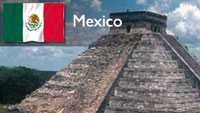A Mexico Climate Overview
Topography of Mexico
 The Climate in Mexico varies according to its topography.
The Climate in Mexico varies according to its topography.
- Along the coast (on both sides of the country) it is hot and humid, unbearably so in the summer.
- Inland communities at higher elevations such as Guadalajara (5200 ft above sea level) and in particular close-by Lake Chapala, are much dryer and more temperate.
- Mexico City (Ciudad de Mexico), with its much higher elevation of 7545 ft (2300 meters) above sea level, can reach freezing temperatures in the winter. You’ll be surprised to find snow-capped volcanoes. San Miguel de Allende also experiences somewhat colder winters due to its close proximity to Mexico City.
Lake Chapala Climate
Lake Chapala falls into the tierra templada category described below. Usually there is a week or two cold spell in January or February that brings temperatures in the low 40s (not depicted on the chart below). While these cold spells do not last long, many local expats resort to portable heaters or a trip to the beach to warm up.
Like most of Mexico, the rainy season lasts from June into early October and drops a little over 30 inches of rain during the five-month period. July is the rainiest month of the year, about 9 inches. Once the rain starts the temperature cools as much as 10 degrees and the mountains turn a lush green again. From November through May, just over two inches of rain falls. Many here are fans of the rainy season because it usually rains at night, cooling everything down and turning the surrounding mountainsides to emerald green.
Spring is the warmest time of the year along Lake Chapala. Daytime temperatures begin warming in March and reach an average high of 90 by May, but relatively low humidity keeps the climate somewhat comfortable during the hot season. The rest of the year the average high ranges from the mid-70s to the low 80s and lows seldom drop below 45 F.
Last but not least, the sun shines well over 300 days each year.
Source BBC – regarding climate in Mexico |
| Mexico, the largest country of Central America, is bordered on the north by the United States and on the south by Guatemala and Belize.About three times as large as Texas, it is shaped roughly like a wedge, widest in the north and tapering to the narrow Isthmus of Tehuantepec in the south. It is situated between 14° and 32°N, the northern half of the country lying outside the tropics.
Almost two-thirds of the country consists of plateaux and high mountains with a climate that is warm-temperate; other parts have a tropical climate with temperature reduced by altitude. There are three important climatic influences which help to determine the character of the climate in Mexico and her different regions. The cold Californian current, which sweeps southwards on the Pacific coast, has the effect of lowering temperatures and reducing rainfall on the west coast as far south as the tip of the peninsula of Lower California. This and the influence of the North Pacific anticyclone help to make much of northwestern Mexico desert or semi-desert; this is a continuation of the dry zone of the United States in southern California, New Mexico, and Arizona. The warm waters of the Caribbean Sea, and the influence of the constant northeast trade winds, make the eastern coastal region a typical tropical coast with a marked single wet season in summer. The weather and climate of this region, particularly south of Tampico, have much in common with that of the Caribbean Islands. An important influence is the presence to the north of the great continental landmass of North America. This area becomes very cold in winter – particularly when cold air sweeps down from the Canadian Arctic – and very warm in summer. The northern part of Mexico shares these extreme temperature conditions. In winter cold waves, or ‘northers’, can bring near-freezing conditions for a few days to the east coast as far south as Tampico or Veracruz. Snow has fallen as far south as Tampico, which is within the tropics. The west coast is protected from such cold waves by the mountains and plateaux of central Mexico. As in other mountainous South and Central American countries, the climatic zones are described on the basis of altitude, using Spanish terms: tierra caliente, the area below about 600 m/2,000 ft; tierra templada, the land between 600 m/2,000 ft and 1,800 m/6,000 ft; and tierra fria, the mountains and plateaux above this level. Only a very narrow coastal belt on the Pacific shore falls into the tierra caliente category, but there is a more extensive area on the Caribbean shore, including the whole Yucatan peninsula. The largest part of Mexico falls into tierra templada and tierra fria. This division takes little account of rainfall and is mainly on the basis of temperature. In most of the tierra fria, frost is frequent at night in winter and snow can occur anywhere, but only lies above 3,000-3,600 m/10,000-12,000 ft. The rainy season over the whole country is the period of high sun from May to October. The rest of the year is not completely rainless, but the amount and frequency of rain in the winter season is low. The wettest part of the country is the lowland on the Caribbean coast; the north coast of the Yucatan peninsula is relatively much drier than the east coast or the interior. Annual rainfall here is between 1,000 m/40 in and 1,500 m/60 in, but some places in northern Yucatan get less than 500 mm/20 in. The shores of the Pacific and Gulf of California, north of the Tropic of Cancer, get less than 250 mm/10 in of rain a year, but this increases southwards to between 1,000 mm/40 in and 1,500 mm/60 in. Rainfall is heaviest where the coast is backed by high mountains. On the plateau, where some of the winter precipitation may fall as snow, the annual rainfall is rather less than on the coast. Much of the plateau is sheltered from maritime influences by the high mountains of the eastern and western Sierra Madre so that it has a reduced rainfall. Annual amounts of 500 mm/20 in or less in the extreme north to 875 mm/35 in in the centre and south are typical of the central highland region. Most of Mexico has sunny weather for a large part of the year. The cloudiest regions are the wetter parts of the east coast and the northern part of the Pacific coast, where low cloud and fog are formed over the cold ocean current. The drier regions of the interior and much of the tierra templada have high amounts of sunshine: as much as seven or eight hours a day in the drier months to five or six during the wetter season. The table for Guaymas is representative of the drier northwest of the country. Conditions in the interior are represented by the tables for Monterrey and Mexico City; these show a larger daily range of temperature. Monterrey is at the upper limit of the tierra caliente, while Mexico City is typical of the tierra fria. The table for Mérida, in northern Yucatan, Acapulco and Salina Cruz, on the Pacific coast in the south, show the higher and typically tropical temperatures of the southern lowlands. Mérida is wetter than some parts of Yucatan. The combination of heat and humidity can be rather uncomfortable during the wet season. Otherwise most of Mexico has a healthy and reasonably pleasant climate for most of the year. At the altitude of Mexico City and above, visitors may take a few days to adjust to the lower atmospheric pressure as sudden exertion can lead to breathlessness. On the higher parts of the plateau the sun may at times feel very powerful by day and the rapid drop of temperature at night may strike very chilly. Both the east and west coasts of Mexico are occasionally affected by tropical storms that develop in the Caribbean or the Pacific and bring two or three days of heavy rain. These are most likely to occur in the months August to October. Very few of these reach the strength of fully developed hurricanes; if they do, the east-coast districts are more liable to severe damage. |
Our interactive online program Move2Mexico RoadMap can be started anytime. It is the perfect educational experience, and covers all essential topics: Health Care, Real Estate, Legal System, Safety, Immigration, Bringing Pets, Cost of Living, US Taxes for Americans, Living on the Lakeside, Investing in Mexico, Mexican Economy and much more. Combine the online program with an exploratory visit to Lakeside for the ultimate “due-diligence” for those serious about making a move to Mexico.
My wife and I recently participated in the Focus on Mexico on line program that covered topics related to moving to Mexico. We have to say it was an excellent program. The topics were presented in a clear and concise way that were timely and detailed. Programs such as Health Care in Mexico, Immigration, Renting or Buying a Home, and more, provided critical information that would have taken weeks, if not longer to discover on our own. The huge advantage was the ability to hear actual, on the ground, professionals such as Doctors, Lawyers and Real Estate Agents in Ajjic and Chapala describe the ins and outs of Mexico. The ability to watch the program from the comforts of home and then have the ability to re-watch the topics is a huge advantage. The cost of the program is worth every penny when you consider the time saved and information provided that will keep you from making costly mistakes later in your journey to Mexico. Kudos to Michael and all the Focus on Mexico presenters. Very well done. Steve and Elena G

Leave a Reply